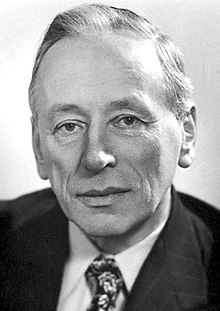Frits Zernike
Frederik "Frits" Zernike (born July 16, 1888 in Amsterdam , † March 10, 1966 in Amersfoort ) was a Dutch physicist and Nobel Prize winner .
Life
Frits Zernike was born as the second of six children to the teacher couple Carl Frederick August Zernike and Antje Dieperink. He had inherited his interest in physics and science from his father, as he neglected non-science subjects at school, and later had to pass a matriculation test in Greek and Latin for university admission. In 1905 he began studying chemistry at the University of Amsterdam with mathematics and physics as minor subjects. In 1913 he became assistant to Jacobus C. Kapteyn at the University of Groningen and received his doctorate in 1915 on critical opalescence . He then taught as a lecturer formathematical physics in Groningen and received a professorship in 1920. In 1958 he retired.
family
Frits Zernike was married twice. After the death of his first wife Dora van Bommel van Vloten (1887–1945), with whom he had a son, he married Lena Koperberg-Baanders (1886–1975) in 1954.
Some of Zernike's siblings also achieved greater prominence: a brother Zernike was also a professor of physics, his sister Anne Zernike was married to the painter Jan Mankes and, as a Mennonite theologian, was the first woman to be ordained as a pastor in the Netherlands, his sister Elisabeth Zernike was a well-known writer Netherlands.
Frits Zernike was the uncle of the physicist Nico van Kampen and the great-uncle of the physicist and Nobel Prize winner Gerardus' t Hooft .
plant
Zernike developed a sensitive galvanometer , which was produced by Kipp and Sons in Delft from 1923 . From 1930 onwards he was occupied with optics and in the same year developed a phase contrast microscope , the importance of which, however, was completely underestimated by the Zeiss works. Only after the German Wehrmacht had taken stock of all inventions that might be of military interest in 1941 were the first microscopes actually manufactured. This gave rise to the grotesque situation that the Wehrmacht helped Zernike's long underestimated invention achieve an industrial breakthrough, while Zernike and his compatriots suffered from the oppression of the same forces during the occupation of the Netherlands . After the war , thousands of phase contrast microscopes were manufactured by several manufacturers, which proved to be very useful in many fields of science, especially medicine .
Zernike was awarded the Nobel Prize in Physics in 1953 "for the phase contrast method he specified, in particular for his invention of the phase contrast microscope".
Zernike made another important contribution to optics with the Zernike polynomials named after him . These are functions that are orthogonal to the unit circle and are used, for example, to describe imaging errors .
Furthermore, the van Cittert-Zernike theorem , which is very important in optics, is named after him and Pieter Hendrik van Cittert , which establishes a relationship between the spatial correlation function of the first order and the associated intensity distribution of an extended incoherent light source (see coherence ).
Awards and honors
- Rumford Medal, Royal Society
- Nobel Prize in Physics , 1953
- The Zernike moon crater is named after him.
Web links
- Information from the Nobel Foundation on the 1953 award ceremony for Frits Zernike (English)
- Literature by and about Frits Zernike in the catalog of the German National Library
- Frits Zernike in the Mathematics Genealogy Project (English)
- Entry for Zernike, Frits (1888-1966) in the Archives of the Royal Society , London
- biography
| personal data | |
|---|---|
| SURNAME | Zernike, Frits |
| ALTERNATIVE NAMES | Zernike, Frederik |
| BRIEF DESCRIPTION | Dutch physicist |
| DATE OF BIRTH | July 16, 1888 |
| PLACE OF BIRTH | Amsterdam |
| DATE OF DEATH | March 10, 1966 |
| Place of death | Amsterdam |

